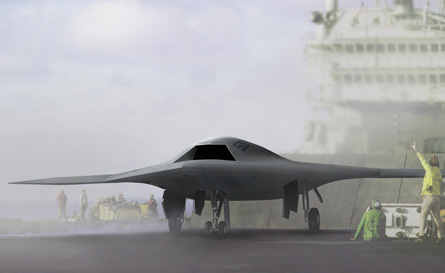The US Navy will start developing within 10 years a stealthy, carrier-based, unmanned air system to participate in a category of combat that US officials now describe as irregular and hybrid warfare.
A request for information issued to industry on 19 March reveals USN officials are planning to develop the unmanned carrier launched airborne surveillance and strike (UCLASS) system. The need has been identified by the deputy chief of naval operations for information dominance, or "N2/N6" in the USN's nomenclature.
The notional system would include four to six air vehicles, each capable of flying 11-14h without refuelling, according to the RFI.
The aircraft would be loaded with sensors and weapons. Attacks would be initiated by a human, rather than allow the vehicle to attack targets autonomously, the document says.
 |
|---|
© Northrop Grumman |
Moreover, the UCLASS system would be available for limited operational use by the end of 2018, allowing carrier-based aviation a new degree of versatility in long-range combat operations, the RFI says.
The USN's timetable suggests the need for a rapid development programme using mature technology.
The RFI's notional requirements appear to call for an aircraft similar to the Northrop Grumman X-47B. Northrop is preparing to launch flight trials later this year under the USN's unmanned combat air system-demonstration (UCAS-D) programme.
Other manufacturers are developing challengers to the X-47B, which include the Boeing Phantom Ray and General Atomics Avenger. Neither, however, is known to be funded by the USN to demonstrate carrier-based operations.
The X-47B is designed to carry a 2,040kg (4,500lb) payload of weapons and sensors off a carrier deck. The aircraft is expected to achieve an unrefuelled range with a full mission payload of 3,880km (2,100nm), which appears too short for the USN's UCLASS requirement.
The X-47B's UCAS-D programme survived a funding scare in mid-2007. At the time, a senior fellow at the Center for Strategic and Budgetary Assessments, Robert Work, launched a successful public campaign to restore the programme's funding. Work now serves in the Obama administration as the under secretary of the navy.
Source: Flight International























